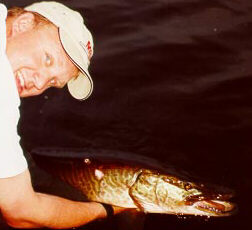|
|

Posts: 32945
Location: Rhinelander, Wisconsin | Here's the article we've been looking for, thanks to Mr. Neuswanger for submitting the piece. Enjoy!
http://muskie.outdoorsfirst.com/articles/05.30.2007/1213/Managing.M... | |
| | |

Location: The Yahara Chain | I really enjoyed the article. Good luck Dave. | |
| | |

Posts: 714
Location: Rhinelander, WI | Very excellent article.
I would be interested to know which lakes out there may be considered for the 40 to 50 protected slot. Dave mentioned some criteria for this limit, but gave no examples, maybe there are none in his area, I am curious if anybody has and lakes that might fit this example.
When we proposed the changes for Pelican Lake, Oneida County we included the option of a 40 to 50 protected slot. I viewed this as more of a political compromise not a biological necessity. To there credit, the local fisheries manager and the Basin manager where not at all in favor of the slot for Pelican as they thought the best management strategy for this lake was high minimum. In fact the basin manager pointed out that he viewed a high slot as a back door to high minimum as most anglers release the 34 to 40 inch fish anyway.
As I said then, I viewed a slot as a political choice, because of the nature of the way management decision are made in Wisconsin. With the high slot the all species angler can still go out and target 34 to 40 musky for the grill, little Jonnie will most likely be able to keep his first legal, at odds say it will be under 40. Again non-biological, but political. As the basin manager stated it’s a back door to high minimums. Which I feel could be important as even though we are at 95% release rate a 45 to 50 inch fish has a much better chance at getting bonked than a 34 to 40 so the slot would still protect those desired spawners, while allowing some flexibility for people who desire to keep a fish or two. I know this is not popular on this board where we are all die hard C&R anglers, but fact of the matter is the system by which our lakes are managed is not 100% biologically driven, decision are made by the voting public, and that needs to be taken into account when biological decisions are made.
Additionally if not for the WDNR we would not have even had 50” on the original proposal to the lake association. We didn’t think it had a prayer of getting any positive votes, they convinced us to add it and it was chosen overwhelmingly by the people in attendance at the meeting as the best course to follow, thank you John K. and Steve A.
Very interesting stuff, thank you for the great article.
Nail A Pig!
Mike | |
| | |
Posts: 178
| Mike, thanks for your kind words of support for the slot concept and for the work of DNR musky experts in your neck of the North Woods. You asked the following:
MIKE ROBERTS: I would be interested to know which lakes out there may be considered for the 40 to 50 protected slot. Dave mentioned some criteria for this limit, but gave no examples, maybe there are none in his area, I am curious if anybody has and lakes that might fit this example.
DAVE: We have a few lakes that may fall into this category, Mike, but the article was getting long, so I did not elaborate there. Since you asked, though, some of the first lakes that come to mind are Moose and Winter lakes in Sawyer County, where we believe fish have the potential to exceed 50 inches, but abundant males stockpiled beneath the current 40-inch minimum length limits may be reducing the odds that females will recruit and eventually grow to trophy size. My biologists currently are assembling a list of lakes for which they would like to propose a 40- to 50-inch slot length limit. In these cases, we will make our recommendations for biological rather than political reasons 
Dave Neuswanger
Fisheries Team Leader, Upper Chippewa Basin
Wisconsin DNR, Hayward | |
| | |
Location: Green Bay, WI | Nice article Dave--I enjoyed the read. But I have a question...
You mentioned that the anglers could not sex a musky (and thus some females might be harvested as well as the males). But I understood that a male muskellunge has a keyhole anal port, while a female's was more round. Is this not the case?
Thanks for the article and the information!
TB | |
| | |
Posts: 178
| Thanks, Tom! I'm always interested in your perspective. You asked the following:
TOM BETKA: You mentioned that the anglers could not sex a musky (and thus some females might be harvested as well as the males). But I understood that a male muskellunge has a keyhole anal port, while a female's was more round. Is this not the case?
DAVE: You're absolutely right, Tom. By examining the urogenital opening, males often can be distinguished from females by the trained eye. Male openings typically have a "keyhole" shape (like a skeleton key); whereas females typically have more of an "8-shaped" opening. But the degree to which these characteristics are clear varies seasonally; and many experienced fishery field workers do not feel 100% confident determining the gender of muskellunge in this manner. Even though it's a reasonable method, I doubt we could expect the average angler to accurately distinguish between males and females during the open fishing season.
I will say this, however, to anglers who are confident using this method of sexing muskellunge. Please use your special knowledge to release all females, including those of legal size (above existing minimum length limits or below future slot limits). If we could target only males with our selective harvest regulations, we probably would. The ability to distinguish males from females allows you to contribute to enlightened conservation of our muskellunge resource voluntarily. Perhaps some education along these lines should accompany the implementation of slot length limits in the future. Thanks again, Tom.
Dave Neuswanger
Fisheries Team Leader, Upper Chippewa Basin
Wisconsin DNR, Hayward
Edited by Dave N 5/31/2007 4:47 PM
| |
| | |
Posts: 154
Location: Appleton, WI | Dave great article. I also believe the key to musky waters (actual all waters) is matching the management goals to the lake biology. As you know this requires great population data. Big problem with budget cuts. Has the DNR ever considered angler data to supplement population surveys? I also believe that to achieve these anglers are going to have to be open to regulations that may vary to a wide degree on different watters. | |
| | |
Posts: 178
| Thanks, Mike. I appreciate your kind words. See my response below...
ESOX CHASER wrote (and asked): Dave great article. I also believe the key to musky waters (actual all waters) is matching the management goals to the lake biology. As you know this requires great population data. Big problem with budget cuts. Has the DNR ever considered angler data to supplement population surveys? I also believe that to achieve these anglers are going to have to be open to regulations that may vary to a wide degree on different watters.
DAVE: Mike, I assume your question goes beyond the occasional statewide angler survey or on-site creel survey. Various natural resource agencies have used volunteer angler information at one time or another. Some of that information can be quite useful. When I coordinated the Missouri Department of Conservation's (MDC) relatively small musky management program, I started the "Showme Muskie Project," which was a means of collecting information on angling effort, catch rate, and size of catch from anglers willing to share that information freely. My good friend Mark Boone continues in that role today in addition to serving as a Fishery Management Biologist for SE Missouri. I think Mark would agree that it's a labor-intensive "add-on" for anyone whose primary responsibilities lie elsewhere.
The time (and expertise) required to set up an effective database, solicit volunteers, communicate REGULARLY with those volunteers (or you'll lose them), and do your regular job can be daunting. It probably explains why most agencies don't do it routinely unless they happen to have someone who specializes in muskellunge management and can devote all their time and talent to it. I know that Jerry Younk (Minnesota DNR's lead musky researcher) ran an effective angler diary program for several years. I got several good ideas from Jerry when I started the project in Missouri. I do not know if Jerry's diary program is still active in Minnesota. Tim Simonson (Wisconsin DNR) has piloted such an effort for the Madison area lakes, but Tim wears many other hats also. And I worked with the Hayward Lakes Chapter of Muskies, Inc. a couple years ago specifically to obtain volunteer catch data to document characteristics of the Lac Courte Oreilles musky fishery. But these efforts have been sketchy, at best.
There are pitfalls with angler diary data. There is no way to know if you have a random cross-section of musky anglers participating, and proficiency in catching fish varies tremendously. Results from one top-notch angler can make his favorite lake, even if mediocre, look like the finest musky fishery on the planet. So those of us who analyze such data often look at it in relative terms over time. If some trend becomes evident based upon the results of a significant number of the SAME volunteers who have participated for many years, that trend (in catch rate or size structure) may mean something. But if volunteers quit, new volunteers start, or the amount of fishing effort for any given body of water changes dramatically, it's hard to know how to interpret the results. That uncertainty, combined with the time required to manage any volunteer program, probably explains why you don't see more of this type of thing.
Dave Neuswanger
Fisheries Team Leader, Upper Chippewa Basin
Wisconsin DNR, Hayward | |
| | |
Posts: 154
Location: Appleton, WI | Some great points about doing angler diary's. I have participated in surveys in other states. The thing I did feel like it did was give people some way helping with management ideas on their favorite waters. I could see muskie guys being tight with this info but it is to the benefit of the lake. | |
| | |
Posts: 929
Location: Rhinelander. | That was a GREAT article. I hope that the musky angler embraces slot limits when they go into affect. As I have preached for years now its just another tool available to use to make musky fishing even better then it allready is. Dave ,thank you so much for getting out there and speaking up for slot limits.
Don Pfeiffer | |
| |
|
 Article by Dave Neuswanger, Fisheries Team Leader
Article by Dave Neuswanger, Fisheries Team Leader Article by Dave Neuswanger, Fisheries Team Leader
Article by Dave Neuswanger, Fisheries Team Leader